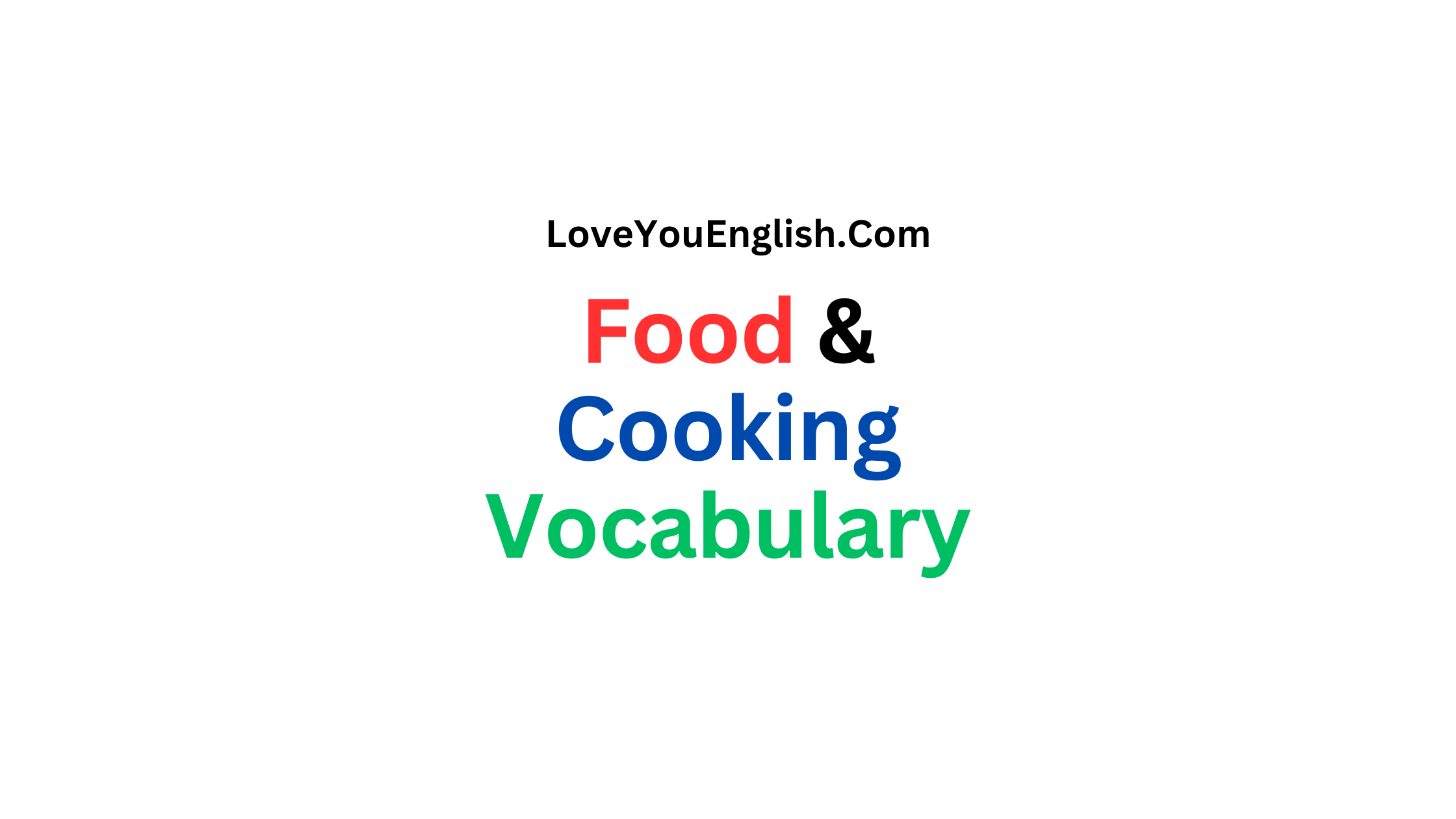Food Vocabulary: How to Talk About Your Favorite Dishes
Food is such a fun topic to talk about!
It connects people, brings back memories, and can even lead to some interesting arguments!
Whether you’re chatting with friends about your favorite meals or picking something to eat at a restaurant, knowing a lot of food words can make your conversations even better.
I will teach you various food vocabulary, learn how to describe tastes, textures, and dishes, and share some tips on how to talk about what you like to eat.
Understanding Food Vocabulary
Food vocabulary includes words about ingredients, cooking techniques, tastes, and different kinds of meals.
Learning these words makes it easier to talk about your food preferences, whether you love something or not.
We can organize the vocabulary into groups to make it simpler to understand.
1. Ingredients
Ingredients are the building blocks of any dish.
Here are some common ingredients categorized by type:
Fruits and Vegetables
- Apple: A sweet, crunchy fruit.
- Banana: A soft, sweet fruit that is great for snacks.
- Carrot: A crunchy vegetable that can be eaten raw or cooked.
- Broccoli: A green vegetable that is rich in vitamins.
Grains and Starches
- Rice: A staple food made from grains, often served with many dishes.
- Pasta: A type of noodle made from wheat flour, available in various shapes.
- Bread: A baked product made from flour, water, and yeast.
Proteins
- Chicken: A versatile meat that can be grilled, fried, or roasted.
- Beef: A rich meat often used in steaks and burgers.
- Tofu: A plant-based protein made from soybeans, popular in vegetarian dishes.
- Eggs: A common protein source, often used in breakfast dishes.
Dairy
- Milk: A liquid produced by cows, goats, or sheep, used in many dishes.
- Cheese: A dairy product made from curdled milk, available in various flavors and textures.
- Yogurt: A creamy dairy product, often enjoyed as a snack or breakfast.
Condiments and Spices
- Salt: A basic seasoning used to enhance flavor.
- Pepper: A spice that adds heat and flavor to dishes.
- Ketchup: A sweet and tangy sauce made from tomatoes, often used with fries.
- Olive oil: A healthy fat used for cooking and dressing salads.
2. Cooking Methods
Knowing different cooking methods can help you describe how a dish is prepared.
Here are some common cooking techniques:
- Boiling: Cooking food in water at high temperatures.
- Frying: Cooking food in hot oil until crispy.
- Grilling: Cooking food over an open flame or hot surface.
- Baking: Cooking food in an oven using dry heat.
- Steaming: Cooking food using steam, often preserving nutrients.
3. Flavors and Textures
When talking about food, it’s important to describe how it tastes and feels.
Here are some common flavor and texture words:
Flavors
- Sweet: A sugary taste, like in desserts.
- Savory: A rich, often salty flavor found in meats and sauces.
- Sour: A tangy taste, like in lemons or vinegar.
- Bitter: A sharp taste found in coffee or dark chocolate.
- Spicy: A hot flavor that can be found in chili peppers.
Textures
- Crunchy: A firm texture that makes a sound when bitten, like chips.
- Creamy: A smooth and thick texture, often found in sauces or desserts.
- Tender: A soft texture that is easy to chew, like cooked vegetables.
- Chewy: A texture that requires more effort to bite, like certain meats or candies.
4. Types of Dishes
Different cuisines have unique dishes that can be categorized in various ways.
Here are some examples:
Appetizers
- Spring Rolls: A crispy roll filled with vegetables or meat, often served with dipping sauce.
- Bruschetta: Toasted bread topped with tomatoes, garlic, and basil.
Main Courses
- Pizza: A flatbread topped with sauce, cheese, and various toppings.
- Curry: A spiced dish, usually with meat or vegetables, served with rice or bread.
Desserts
- Cake: A sweet baked treat, often frosted and decorated.
- Ice Cream: A frozen dessert made from cream and sugar, available in many flavors.
Beverages
- Juice: A drink made from squeezing fruits.
- Tea: A hot or cold beverage made from steeping tea leaves.
How to Express Your Favorite Dishes
When talking about your favorite dishes, you can follow a simple structure: Describe the dish, its ingredients, how it’s made, and why you like it.
Here are some examples:
Example 1: Pizza
“My favorite dish is pizza. It has a thin, crispy crust topped with tomato sauce, mozzarella cheese, and fresh basil. I love it because it’s customizable—I can add my favorite toppings like mushrooms, olives, or pepperoni. Plus, it’s delicious when it’s hot and cheesy!”
Example 2: Pasta
“I enjoy pasta, especially spaghetti. It’s made from wheat and water, and it has a nice chewy texture. I love it with marinara sauce, which is made from tomatoes, garlic, and herbs. Pasta is comforting and reminds me of family dinners.”
Example 3: Chocolate Cake
“One of my favorite desserts is chocolate cake. It’s made with rich cocoa powder and topped with creamy chocolate frosting. It’s sweet and decadent, perfect for celebrations. I always feel happy when I eat it!”
Tips for Talking About Food
- Use Descriptive Words: Use adjectives to make your descriptions vivid. Instead of saying “I like cake,” say “I love moist chocolate cake with rich frosting.”
- Share Personal Stories: Connect your favorite dishes to personal experiences. This makes your conversation more engaging. For example, “I love my grandmother’s apple pie because she makes it every Thanksgiving.”
- Ask Questions: Engage others by asking about their favorite dishes. Questions like “What’s your favorite dessert?” or “Do you prefer spicy food?” encourage dialogue.
- Be Open to New Foods: Express curiosity about different cuisines. Saying, “I’d love to try sushi someday!” shows your willingness to explore new flavors.
Practice Food Vocabulary
To practice your food vocabulary, try the following activities:
- Create a Food Diary: Write down the dishes you eat each day. Describe them using the vocabulary you’ve learned.
- Cook Together: Invite friends or family to cook a dish together. Use food vocabulary while cooking and eating.
- Join Food Discussions: Participate in online forums or local groups focused on food. Share your favorite dishes and learn about others.
- Visit Restaurants: Try new restaurants and pay attention to the menu descriptions. Practice describing what you ordered afterward.
Conclusion
Knowing food vocabulary is super important for sharing what you like to eat and making friends.
When you learn about different ingredients, how to cook them, the tastes, and the kinds of meals, you can have fun chats about food.
Don’t forget to use colorful words, tell your own stories, and ask questions to keep the conversation lively.
So, the next time you hang out with friends or go to a restaurant, you’ll feel more sure about talking about your favorite meals.
Have a great time discovering new flavors, textures, and cooking adventures!
Enjoy your meals!







